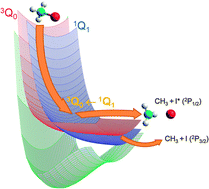The photodissociation of CH3I in the blue edge (217–230 nm) of the A-band has been studied using a combination of slice imaging and resonance enhanced multiphoton ionization (REMPI) detection of the CH3 fragment in the vibrational ground state (ν = 0). The profiles of the CH3 (ν = 0) kinetic energy distributions and the photofragment anisotropies are interpreted in terms of the contribution of the excited surfaces involved in the photodissociation process, as well as the probability of non-adiabatic curve crossing between the 3Q0 and 1Q1 states. In the studied region, unlike in the central part of the A-band where absorption to the 3Q0 state dominates, the I(2PJ), with J = 1/2, 3/2, in correlation with CH3 (ν = 0) kinetic energy distributions show clearly two contributions of different anisotropy, signature of the competing adiabatic and non-adiabatic dynamics, whose ratio strongly depends on the photolysis wavelength. The experimental results are compared with multisurface wave packet calculations carried out using the available ab initio potential energy surfaces, transition moments, and non-adiabatic couplings, employing a reduced dimensionality model. A good qualitative agreement is found between experiment and theory and both show evidence of reverse 3Q0 ← 1Q1 non-adiabatic dynamics at the bluest excitation wavelengths both in the fragment kinetic energy and angular distributions.

You have access to this article
 Please wait while we load your content...
Something went wrong. Try again?
Please wait while we load your content...
Something went wrong. Try again?


 Please wait while we load your content...
Please wait while we load your content...